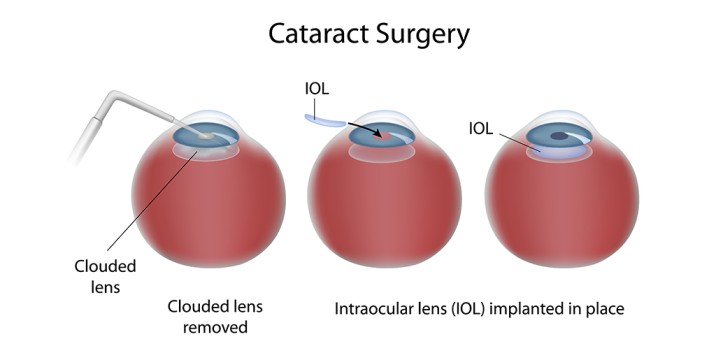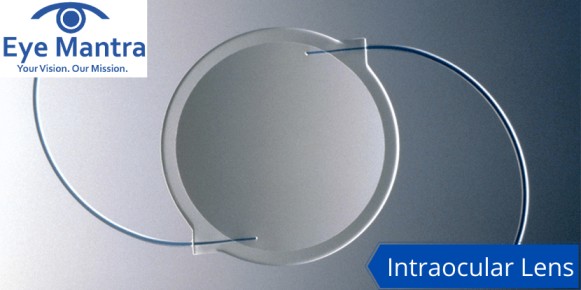Contents
- 1 What Is Intraocular Lens (IOL)?
- 2 History of IOL Implant Surgery
- 3 Use of Intraocular Lens (IOLs)
- 4 Common Types of IOL (Intraocular Lens)
- 5 Types of Pseudophakic IOLs
- 6 Is IOL Surgery Risky?
- 7 The Recovery Period After IOL Implant Surgery
- 8 How Long Does IOL Last?
- 9 Advantages of IOL Exchange
- 10 Disadvantages of IOL Exchange
- 11 Difference between LASIK Surgery And IOLs
What Is Intraocular Lens (IOL)?
There are a few things about aging you just can’t control. Take your eyesight for example. You can fight it but after a certain age, the fine prints on paper get harder to read. With aging, cataract confirms. You lose your eye vision in a cataract. What happens is that the eye lens gets covered with a cloudy substance which results in vision loss. To cure it, the doctors perform cataract surgery. IOL (Intraocular lens) is a special type of lens that helps in vision gain when placed on the surface of the eye. The new lens implant takes care of the cloudiness caused by the cataract.
An IOL (Intraocular Lens) is a small, lightweight, clear plastic disk placed within the eye during cataract surgery. It rectifies the focusing power of the eye’s natural lens. The lens plays a crucial role in focusing images on the retina. If the lens loses its vision clarity because it does when a cataract develops, light rays don’t focus clearly and thus the image one sees becomes blurry.
Intraocular lenses have many advantages. Unlike contact lenses, the IOL remains within the eye after surgery. There is no need of removing, cleaning, and reinserting,
It may be placed either before or behind the iris. Behind the iris is the foremost frequent placement site. They go to be hard plastic, soft plastic, or soft silicone. Soft, foldable lenses are often inserted through a touch incision which shortens recovery time follow surgery. The rapid evolution of IOL (Intraocular Lens) designs, materials, and implant techniques have made them secure and practical due to restoring normal vision after cataract surgery.
History of IOL Implant Surgery
At St. Thomas’s Hospital London, the first IOL implant surgery, with a lens manufactured using “polymethylmethacrylate” (PMMA), was performed. Sir Harold Ridley performed it in 1949.
Sir Ridley opted for ”Polymethylmethacrylate” (also called “Perspex” or “Plexiglas) because he noticed that it stayed motionless within the eyes of Royal Air Force pilots when it entered accidentally from windshields.
PMMA lenses are seldom used nowadays since the fabric is rigid and can’t be folded. This entails a way bigger incision to put it within the attention. With advances in technology, silicone and acrylic became popular materials to be utilized in intraocular lenses. These are soft and foldable materials. Smaller incision helps in insertion into the attention.
Use of Intraocular Lens (IOLs)
There are mainly two purposes of IOLs in general. They are:
- Correcting cataract
- Treating myopia
Common Types of IOL (Intraocular Lens)
Some of the common forms of IOLs are:
1) Anterior Chamber Lenses (ACIOL)
These lenses are placed on top of the iris. It is not the physiological position of the natural lens of the attention, and this sort of lens isn’t the popular IOL after non-complicated cataract surgery. ACIOLs are implanted just in case the posterior capsule of the lens is deficient or damaged.
2) Posterior Chamber Lenses (PCIOL)
These lenses are tucked into the place over the residual posterior capsule within the physiological position of the natural lens of the attention and are the favored lenses.
Types of Pseudophakic IOLs
Pseudophakic IOLs are of three broad categories. that may be implanted during cataract surgery:
1) Monofocal Intraocular Lens
Monofocal lenses, unlike the natural lens of the attention, can only restore vision for one distance, that’s for distance, or for near. The facility of the Monofocal Intraocular lenses is typically calculated so that the patient doesn’t need glasses for sight.
Below are the various sorts of Monofocal Intraocular lenses:
• Aurium (Monofocal): Medennium (USA) manufactures Aurium mono-focal lenses. These lenses are photochromatic, which suggests they become lightly tinted during daytime or bright light and thus prevent harmful UV. Under normal lighting, these lenses become transparent.
• Aurovue (Monofocal): It’s an Indian Company – Aurolab manufactures Aurovue lenses. These lenses are considered entry-level options for cataract surgery and are recommended for somebody on a coffee budget.
• Akreos AO (Monofocal): Akreos AO are almost like Aurovue lenses. However, these are the lenses that are imported and are manufactured by Bausch & Lomb (USA).
2) Multifocal Intraocular Lens
Multifocal IOLs are lenses that supply an appropriate restoration of vision for both near and distance. While choosing an IOL, it’s vital to recollect that multifocal lenses provide you freedom from glasses for both near and distance, and will be customized to your active lifestyle. Following are the sole multifocal lenses:
- Tecnis Symphony (Multifocal): Abbott (USA) manufactures Tecnis Symphony multifocal lenses. This lens provides good distance vision and excellent intermediate vision (computer working).
- Alcon Pantopix (Multifocal): It’s the foremost vital introduction in multi-focal lenses. The lens is during an edge to supply excellent vision certain distance, immediate and near.
3) Toric Intraocular Lens
An eye can have two sorts of power, spherical power which is because of the natural lens within the attention, and cylinder power which is because of the dissymmetry within the curve of the cornea. Monofocal and Multifocal Lenses can only correct the spherical component of the attention. These both don’t bother about and therefore leave the cylinder power. the cylindrical power requires later correction and additional prescription glasses. Toric Lenses can correct both spherical and cylinder components of the attention. Doctors recommend Toric lenses if you’ve got a high pre-existing cylinder or astigmatism in your eye.
Is IOL Surgery Risky?

There are a few and rare risks involved in IOL implantation surgery. However, these are rare but your eyes may catch an infection, start bleeding, turn red, and get swollen. Some other risks are as follows:
- Vision loss
- Dislocation of the lens
- Retinal detachment.
The Recovery Period After IOL Implant Surgery
Any surgery needs time to heal. So does IOL implant surgery. The healing time depends on the severity and the complications of each surgery operated on to each person individually. But, usually, it takes around seven to eight weeks to get completely healed. During this period, try and keep your treated eye covered with eyeglasses. It should not be left uncovered even while you are asleep.
How Long Does IOL Last?
Fortunately, unlike your eye lens, the IOLs do not seize up. Therefore, they don’t need to get replaced. To avail the benefits of these long-lasting lenses, patients need to follow some of the aftercare steps to keep the functioning of the IOLs in condition. Here are the steps you need to take care of after your cataract surgery and IOL implantation:
- Provide yourself with sleep and rest
- Avoid touching your eyes
- Never rub your eyes
- Follow up with your medications as prescribed
- Clean up your hands before using any eye drops.
Advantages of IOL Exchange
The advantages of IOL implantation vary based on various IOLs. The following are the benefits of different IOLs:
- Monofocal IOL provides you with good vision for distance, that too without glasses. Especially, the aspheric monofocal lens helps you by giving clearer vision in dim light and restricts glare and halos.
- Toric IOL corrects significant cylindrical power and sharpens the distance vision without glasses.
- Multifocal IOL also helps in enhancing good vision for both, distant and nearby objects. It also tackles with the issues of glare and halos during the night.
- Trifocal IOL (or Panoptix) helps in better light transmission. In addition to this, it lowers the chance of glare and haloes at night. They also help to enhance good computer vision.
Disadvantages of IOL Exchange
With all the IOLs mentioned above, there comes a common disadvantage. It is:
- With monofocal IOL, you will need to wear eyeglasses while reading, working on the computer, or for any other near vision work.
- ForToric IOL as well, you will need extra eyeglasses for near vision.
- With multifocal IOL also, the person would need an extended aid for near vision clarity.
- Near vision, clarity is difficult with trifocal IOL (or panoptix).
Difference between LASIK Surgery And IOLs
Following are the difference between LASIK surgery and IOLs
- The procedure involved in IOL is much more complex than that of LASIK surgery.
- In terms of recovery, LASIK takes lesser time than IOL implantation surgery.
- IOLs need intraocular surgery and therefore are non-foldable structures whereas in LASIK surgery there is no need for intraocular surgery, and hence has foldable structures.
If you are facing eye pain or some other disturbance of the eyes, please visit an eye specialist Now. To book an appointment with expert ophthalmologists with many years of experience, call at +91- 9711115191
To know more, please visit Eyemantra. Or you can email us on [email protected]. We specialize in Cataract Surgery, Specs Removal, Retina Surgery, and many more.
Related Articles:
Eye Infection: Common Causes, Symptoms and Treatment in Delhi
Eye Drops: Best Tips to Use & Treat Dry eyes, Cataract, Redness



